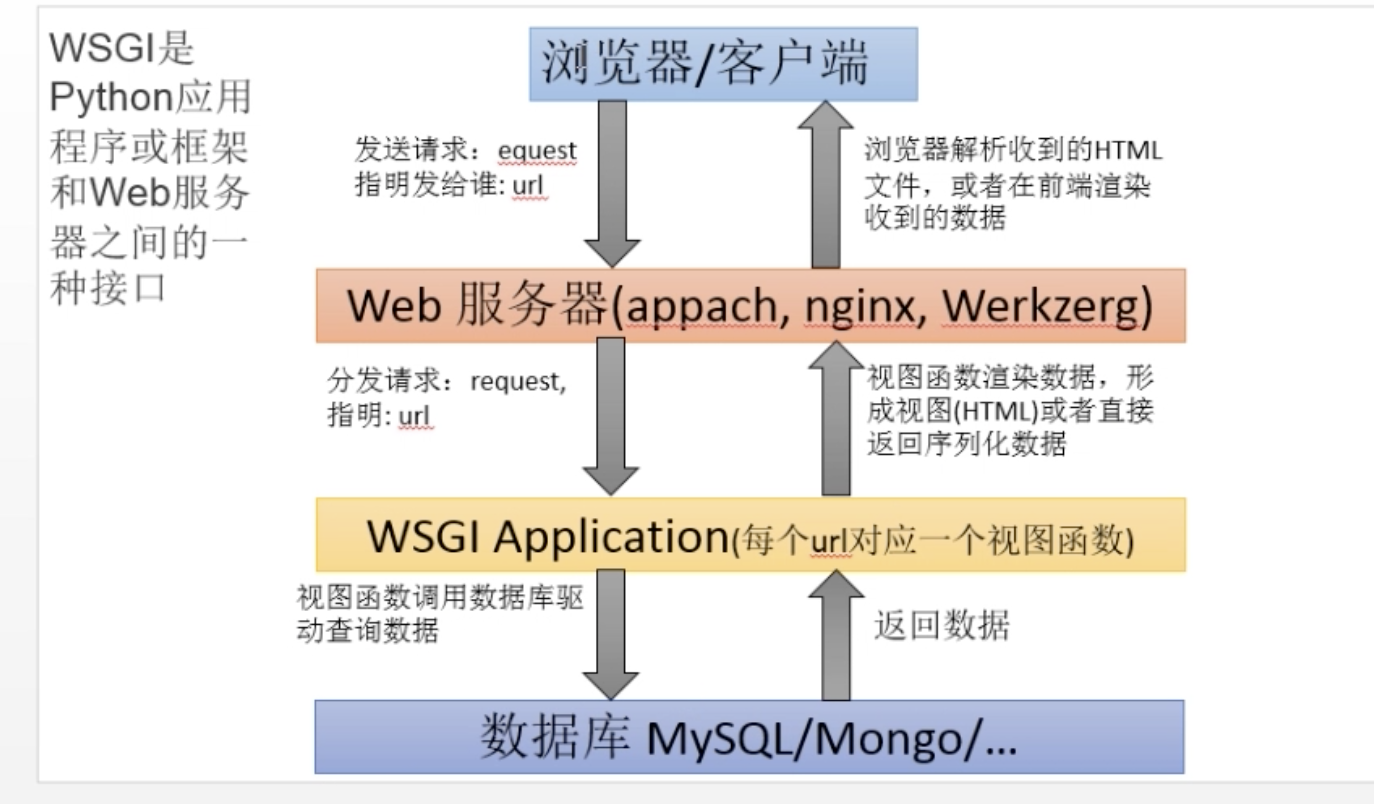推荐阅读
Python Web应用工作流程
下面图来自网上:

WSGI

为什么需要建立WSGI规范
pep-3333建议在Web服务器和Web应用程序/Web框架之家建立一种简单统一的接口规范, 即Python Web服务器网关接口(简称WSGI)。以确保Web应用程序在不同的Web服务器之间具有可移植性。
参考资料
编写代码
代码部分参考的是手撸个简单的 python web 框架教程, 我觉得这个python童鞋讲的挺好。
# wsgi_demo.py
import pprint
# 导入python内置的wsgi server
from wsgiref.simple_server import make_server
def application(environ, start_response):
"""
:param environ: 包含一些特定的WSGI环境信息的字典, 由WSGI服务器提供
:param start_response: 生成WSGI响应的回掉函数, 接受两个必要的位置参数和一个可选参数。status,response_headers和 exc_info
:return: 响应体的的迭代器
"""
pprint.pprint(environ)
status = '200 ok'
response_headers = [('Content-type', 'text/html;charset=utf8')]
start_response(status, response_headers)
return ['<h1>Hello, web!</h1>'.encode()]
if __name__ == '__main__':
httpd = make_server('0.0.0.0', 5000, application)
httpd.serve_forever()
通过命令行跑起这个server.
python wsgi_demo.py
通过另外一个命令行使用curl链接:
~$ curl http://0.0.0.0:5000/
<h1>Hello, web!</h1>
常用的environ
environ字典被用来包含这些CGI环境变量。 关于理解CGI/WSGI/uWSGI可以看看这个解释tornado cgi wsgi uwsgi之间的关系?
1. REQUEST_METHOD
HTTP的请求方式,比如 "GET" 或者 "POST"。这个参数永远不可能是空字符串,故必须指定。
2. PATH_INFO
URL请求中‘路径’(‘path’)的其余部分,指定请求的目标在应用程序内部的虚拟位置。如果请求的目标是应用程序根目录并且末尾没有'/'符号结尾的话,那么PATH_INFO可能为空字符串 。
3. QUERY_STRING
URL请求中紧跟在“?”后面的那部分,它可以为空或不存在。
4. CONTENT_TYPE
HTTP请求中Content-Type字段包含的所有内容,它可以为空或不存在。
5. HTTP_ 变量组
这组变量对应着客户端提供的HTTP请求报头(即那些名字以 “HTTP_” 开头的变量)
...
我们其实上面通过
pprint.pprint(environ)
可以查看到里面所包含的信息。
{
'Apple_PubSub_Socket_Render':'/private/tmp/com.apple.launchd.9BSE0tnnTO/Render',
'CLICOLOR': '1',
'COLORFGBG': '7;0',
'COLORTERM': 'truecolor',
'CONTENT_LENGTH': '',
'CONTENT_TYPE': 'text/plain',
'FLUTTER_STORAGE_BASE_URL': 'https://storage.flutter-io.cn',
'GATEWAY_INTERFACE': 'CGI/1.1',
'GOBIN': '/Users/xx/Documents/goBin',
'GOPATH': '/Users/xx/Documents/goWorkPlace',
'GOROOT': '/usr/local/go',
'HOME': '/Users/xx',
'HTTP_ACCEPT': '*/*',
'HTTP_HOST': '0.0.0.0:5000',
'HTTP_USER_AGENT': 'curl/7.54.0',
'ITERM_PROFILE': 'Default',
'ITERM_SESSION_ID': 'w0t0p0:D66287F5-65FC-4141-94AC-06A1B3CBEAE4',
'LANG': 'zh_CN.UTF-8',
'LOGNAME': 'xx',
'LSCOLORS': 'exfxhxhxgxhxhxgxgxbxbx',
'PATH': '/Users/xx/.local/share/virtualenvs/flask-demo-MqfCTpGB/bin:/Users/xx/Documents/flutter/bin:/Users/xx/.pyenv/plugins/pyenv-virtualenv/shims:/Users/xx/.pyenv/plugins/pyenv-virtualenv/shims:/Users/xx/.pyenv/shims:/usr/local/bin:/usr/bin:/bin:/usr/sbin:/sbin:/usr/local/go/bin:/Users/xx/.local/bin:/usr/local/go/bin:/Users/xx/Documents/goBin',
'PATH_INFO': '/',
'PIPENV_ACTIVE': '1',
'PIP_DISABLE_PIP_VERSION_CHECK': '1',
'PIP_PYTHON_PATH': '/Users/xx/.pyenv/versions/3.6.0/bin/python3.6',
'PS1': '(flask-demo) \\[\\033[01;33m\\]\\u \\W\\$\\[\\033[00m\\] ',
'PUB_HOSTED_URL': 'https://pub.flutter-io.cn',
'PWD': '/Users/xx/Documents/GitHub/flask-demo',
'PYENV_SHELL': 'bash',
'PYENV_VIRTUALENV_INIT': '1',
'PYTHONDONTWRITEBYTECODE': '1',
'QUERY_STRING': '',
'REMOTE_ADDR': '127.0.0.1',
'REMOTE_HOST': '',
'REQUEST_METHOD': 'GET',
'SCRIPT_NAME': '',
'SERVER_NAME': 'XxdeMacBook-Pro.local',
'SERVER_PORT': '5000',
'SERVER_PROTOCOL': 'HTTP/1.1',
'SERVER_SOFTWARE': 'WSGIServer/0.2',
'SHELL': '/bin/bash',
'SHLVL': '2',
'SSH_AUTH_SOCK': '/private/tmp/com.apple.launchd.qMWayGCpdP/Listeners',
'TERM': 'xterm-256color',
'TERM_PROGRAM': 'iTerm.app',
'TERM_PROGRAM_VERSION': '3.2.0',
'TERM_SESSION_ID': 'w0t0p0:D66287F5-65FC-4141-94AC-06A1B3CBEAE4',
'TMPDIR': '/var/folders/6g/kjvjmf8j59j2tf2mm360dqjm0000gn/T/',
'USER': 'xx',
'VIRTUAL_ENV': '/Users/xx/.local/share/virtualenvs/flask-demo-MqfCTpGB',
'XPC_FLAGS': '0x0',
'XPC_SERVICE_NAME': '0',
'_': '/Users/xx/.local/share/virtualenvs/flask-demo-MqfCTpGB/bin/python',
'__CF_USER_TEXT_ENCODING': '0x1F5:0x19:0x34',
'wsgi.errors': <_io.TextIOWrapper name='<stderr>' mode='w' encoding='UTF-8'>,
'wsgi.file_wrapper': <class 'wsgiref.util.FileWrapper'>,
'wsgi.input': <_io.BufferedReader name=6>,
'wsgi.multiprocess': False,
'wsgi.multithread': True,
'wsgi.run_once': False,
'wsgi.url_scheme': 'http',
'wsgi.version': (1, 0)
}
在application里面我们通过environ获得我们需要的很多参数, 比如请求的查询字符串等。
封装Request对象
# request.py
from six.moves import urllib
class Request(object):
"""接受environ参数, 然后一些子函数供外界使用去获取需要的值"""
def __init__(self, environ):
self.environ = environ
def args(self):
""" 把查询参数转成字典形式 """
get_arguments = urllib.parse.parse_qs(
self.environ['QUERY_STRING']
)
return {k: v[0] for k, v in get_arguments.items()}
def path(self):
return self.environ['PATH_INFO']
封装Response对象
# response.py
import http.client
from six.moves import urllib
from wsgiref.headers import Headers
class Response(object):
"""返回内容, 状态码, 字符编码, 返回类型等"""
def __init__(self, response=None, status=200,
charset='utf-8', content_type='text/html'):
self.response = [] if response is None else response
self.charset = charset
self.headers = Headers()
content_type = '{content_type}; charset={charset}'.format(
content_type=content_type, charset=charset)
self.headers.add_header('content-type', content_type)
self._status = status
@property
def status(self):
status_string = http.client.responses.get(self._status, 'UNKNOWN')
return '{status} {status_string}'.format(
status=self._status, status_string=status_string)
def __iter__(self):
for val in self.response:
if isinstance(val, bytes):
yield val
else:
yield val.encode(self.charset)
装饰器函数
# transfer.py
from request import Request
def request_response_application(func):
"""把WSGI 函数转换成使用Request/Response 对象"""
def application(environ, start_response):
request = Request(environ)
response = func(request)
start_response(
response.status,
response.headers.items()
)
return iter(response)
return application
改版后的demo
# wsgi_demo.py
import pprint
# 导入python内置的wsgi server
from wsgiref.simple_server import make_server
from transfer import request_response_application
from response import Response
@request_response_application
def application(request):
# 获取查询字符串中的 name
name = request.args().get('name', 'default_name')
return Response(['<h1>hello {name}</h1>'.format(name=name)])
if __name__ == '__main__':
httpd = make_server('0.0.0.0', 5000, application)
httpd.serve_forever()
测试demo
python wsgi_demo.py
默认情况:
~$ curl http://0.0.0.0:5000/
<h1>hello default_name</h1>
带有name的查询字符串
~$ curl http://0.0.0.0:5000/demo?name=kobe
<h1>hello kobe</h1>